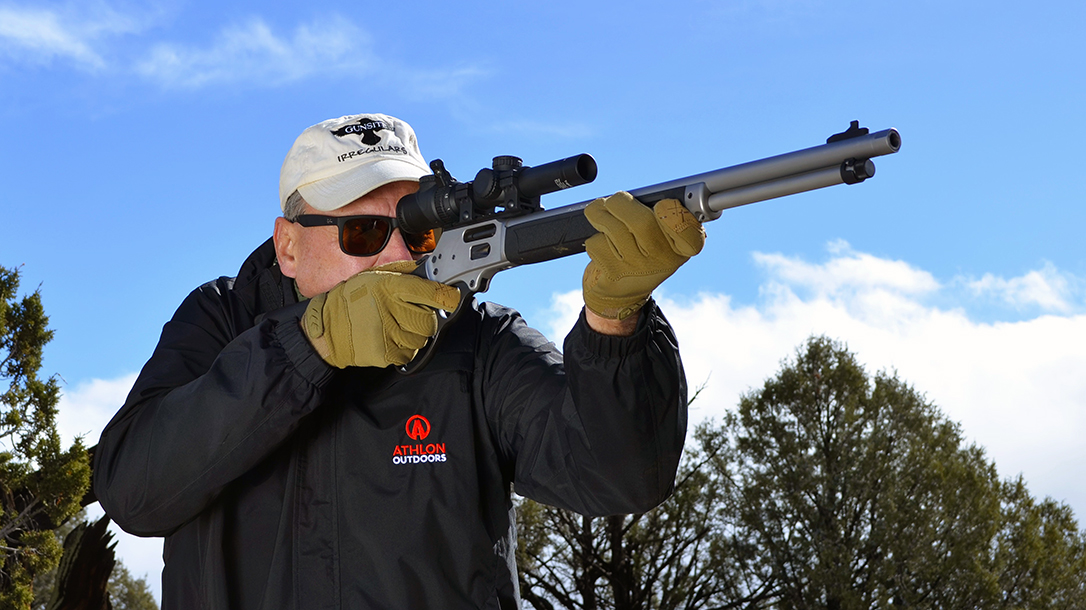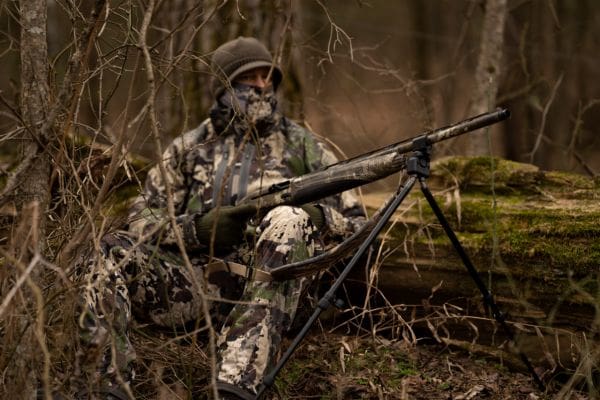I received an email for a new product from Smith & Wesson the first week of January. I wondered aloud what it could be? A new variation of the popular M&P9 pistol? Maybe a different variation of the M&P15 Modern Sporting Rifle? Possibly even a pistol version of their new Response 9mm pistol caliber carbine? It turned out to be none of those things. Instead, the product release was for S&W’s brand-new lever-action rifle, chambered for .44 Magnum. You could have knocked me over with a feather. But I was ready to start shooting the new Smith & Wesson Model 1854!
Shooting the Smith & Wesson Model 1854
The press release reminded us that this would not be S&W’s first lever-action. The Volcanic lever-action was patented in 1854. Paying homage to this first lever gun, S&W’s latest rifle will be called the Model 1854. To be clear, this is not a reissue or replica of the Volcanic. The 1854 comprises an entirely new gun with features savvy lever-gun aficionados will love!
Year of the Lever Gun
I received my Test & Evaluation sample a mere week later, just before heading to the SHOT Show. During our annual trade show, sponsored by the National Shooting Sports Foundation (NSSF), manufacturers often debut their newest products. I was dreading the show wondering how many new and different derivations of AR-15s would be displayed.
Happily, I found the 2024 SHOT Show to be the year of the lever gun! There were countless companies that displayed new lever guns–some with detachable box magazines, while others featured free-floating handguards and mounts for red dot sights. I suppose there are several reasons for this new explosion of lever guns, but I think mostly, the AR market is over saturated. Talks of bans and further restrictions plus an overabundance of inventory, which forces prices lower, have caused industry insiders to take a hard look at alternatives.
1854 Boasts 2024 Updates
S&W’s 1854 release was timed perfectly. Examining the gun revealed that it possesses a number of traditional features and some new and innovative updates to make this the perfect pick-up gun for a rancher, woods hunter and plinker. Its construction provides all-weather protection, and the inclusion of a receiver top Picatinny rail gives the shooter a number of sighting options.
The Model 1854 possesses a large loop lever that should be easy for shooters to use even with winter gloves. Its buttstock boasts textured grip panels, a rubber recoil pad and a sling swivel stud. Its forend is also synthetic and boasts M-LOK attachment points for accessories as well as a stainless steel forend cap with a hole for mounting a forward sling swivel. Weighing less than seven pounds, the Model 1854 has a wonderful balance and quick-handling characteristics that should make it perfect for snap shooting.
A Closer Look
S&W machines the receiver from a forging of 416 stainless steel. The closed top receiver has a detachable Picatinny rail for mounting optics but also possesses a peep sight, adjustable for windage and elevation, for those who prefer iron sights. Its front sight possesses an easily visible, in most light, gold dot. A loading gate and ejection port are located on the right side of the 1854’s receiver.
There is a simple cross bolt safety on the receiver that is easily accessible to the trigger finger while in firing position. With the safety in its “on” position, protruding from the right side of the receiver, it blocks the hammer from the firing pin. More on this later.
Our test sample sports a 19.25-inch barrel that is constructed from 410 stainless-steel. S&W rifles the barrel with a slow 1:20” right-hand twist, eight-groove, that seems to favor heavier projectiles. Its muzzle is threaded with 11/16-24 for suppressor use, and the rifle comes with a protective thread cap.
Like most conventional lever guns, the Model 1854 uses a tubular magazine that holds nine rounds of .44 Magnum. Of course, shooters can also load and shoot .44 Special rounds in the 1854, and they will feed and fire fine! S&W engineers designed the gun to have a removable inner tube so the magazine can be unloaded without levering each round through the chamber. That’s a handy and useful feature!
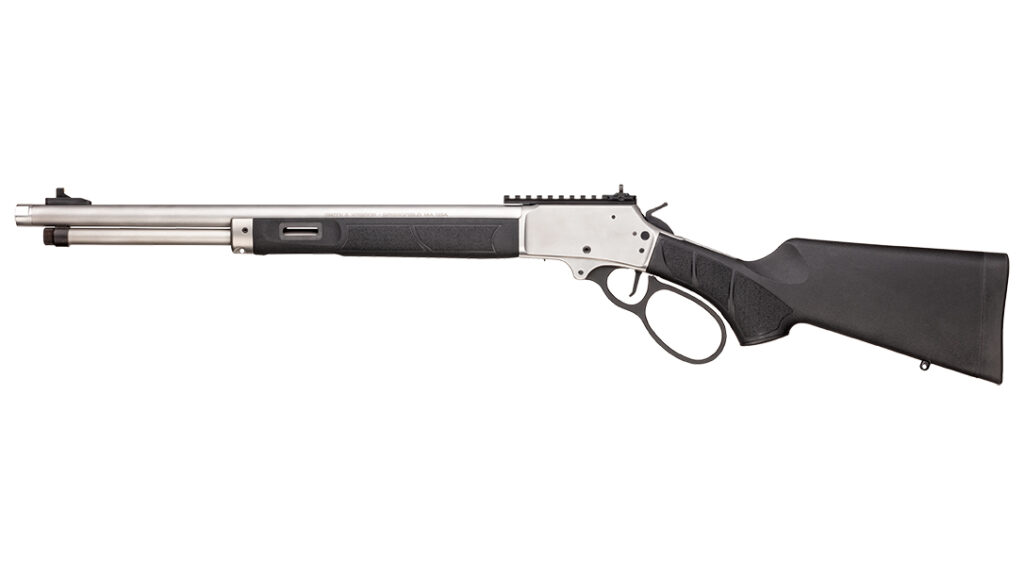
Multiple Carry Options
There are a number of ways to carry the Model 1854 in the field. Perhaps the most simple option would be to carry the rifle with an empty chamber and lever a round into the chamber when ready to fire. If you’re afraid this might spook your quarry, engage the crossbolt safety, drop a round into the chamber through the ejection port and close the lever. After ensuring the safety is engaged, hold the hammer back while adding pressure to the trigger until it breaks. Now slowly lower the hammer to its half-cock position. When you’re ready to fire, cock the hammer back to full cock and push the receiver’s crossbolt safety from right to left. Pressing the trigger will now fire the gun.
Seeing is Believing–Sighting Options
I’ve already mentioned that S&W attaches a piece of Picatinny rail to the flat-top receiver. It possesses an XS Sights ghost ring peep sight that is adjustable for both windage and elevation. It’s a fast setup and should be perfect for use in thick woods or open plains. But the rail provides a number of sighting options that the shooter should consider based on the type of shooting they’ll be doing.
I grew up in Pennsylvania and hunted the woods of Carbon County, where most shots were under 50 yards. For those conditions there’s absolutely nothing wrong with the iron sights the rifle comes issued with. Now that I’m older and my eyesight has degenerated, I might consider mounting a red dot on the rail. Living in Arizona now, most shots would likely be at longer range with game out in the open. A good variable scope would be perfect for hunting in the Sonoran desert.
Trijicon 1-6X AccuPoint
Many years ago, when I was an active 3-gun competitor, the Trijicon 1-4X Accupoint was my scope of choice. I loved the clear bright optics, and its fiber-optic/Tritium aiming point was visible in any lighting. Trijicon sent me a brand new 1-6X AccuPoint to test the new 1854 with. The second focal plane (SFP) scope has a circle-cross crosshair with a 25 MOA circle for close and fast reflex shots, and a fine crosshair with a green dot, that is adjustable for brightness, at its center. It has a quick-throw magnification lever so I can go from 1X to 6X in the blink of an eye. With the magnification set at 1X the scope essentially becomes a reflex sight and has all the advantages of a red dot and can be shot with both eyes open, making it incredibly quick!
There is an easy-to-focus ring at the rear ocular, and the windage and elevation turrets are easy to adjust and come with caps that can be easily manipulated, even with gloves. Trijicon sent me a set of standard rings with the scope, so it sits as close to the receiver as possible for a low profile.
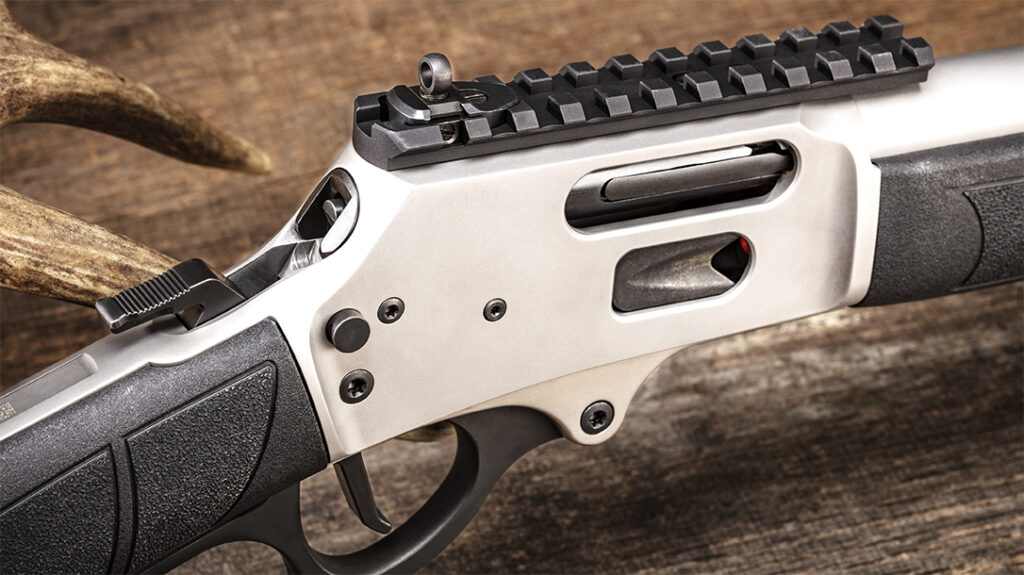
Gunsite Tested
I was heading to Gunsite for an unrelated media event, just after SHOT Show, so I threw the rifle in with the rest of my gear. When I got to Gunsite’s campus, Training Coordinator, Dave Hartman, gave me the use of the Shot Quad range. I set up my DOA Tactical portable shooting bench at the 50-yard-line and used a Caldwell sandbag for support when I fired my groups. I fired five rounds to a group and three groups with each ammunition, and the accuracy chart reflects the best group.
Thanks to the Trijicon scope, it was an easy matter to get the scope sighted in quickly. I fired all of my groups with the scope set on 6X and used Black Hills 240-grain JHP rounds for sighting purposes. My best group with this ammunition was just 1.1 inches! This is far better than I expected, and besides the great ammo and optics, the other thing that made these small groups possible is the 1854’s trigger. My test sample’s trigger breaks cleanly at 3.75 pounds. I love that S&W outfitted the gun with a flat-faced trigger, and I feel it gives the shooter more control and consistency and it features a lip at its bottom to keep the pad of the index finger centered.
Accuracy Results
| Ammunition | Velocity | Group |
| Black Hills .44 Magnum 240-grain JHP | 1440 | 1.10” |
| Doubletap .44 Magnum 225-grain Solid Copper Hollow Point | 1625 | 1.58” |
| Doubletap .44 Special 240-grain Hardcast | 1135 | 1.79” |
| Hornady .44 Magnum 225-grain FTX LEVERevolution | 1612 | 1.82” |
| Hornady .44 Special 165-grain FTX, Critical Defense | 1135 | 2.16” |
| Average | 1.69” |
I had brought along some .44 Special handloads that I loaded for handguns. It’s a mild load and the 240-grain hardcast loads only averaged about 875 feet per second from the 1854’s 19.25-inch barrel. Groups with those handloads were closer to 2.75 inches at 50 yards. While not the tack-driving accuracy that Black Hills 240-grain ammo provided, they were exceptionally mild to shoot. In fact, recoil was almost unnoticeable, and these rounds would be perfect for the new, recoil sensitive and/or younger shooters to fire with the 1854.
Not for nothing, 2.75 inches at 50 yards is nothing to sneeze at and will take care of most shooters’ needs, from plinking to hunting to personal defense. If I had more time and different loads available, I would love to experiment with heavier projectiles. Given the 1:20 twist, I think some bullet weights between 275 and 300 grains would provide some really outstanding accuracy.
Scrambling Through the Scrambler
Gunsite’s Scrambler is a field course that involves the shooter engaging steel targets at distances between 75 and 150 yards, from various positions while utilizing natural terrain features for support. Between snowstorms, Gunsite instructor Aimee Grant ran me through the Scrambler. Grant, a former Marine and veteran law enforcement officer from southern California, is one of my favorite instructors, and she spotted for me as I ran, or more accurately limped, through the course.
I started with the AccuPoint set at 1X and as targets increased in distance eventually dialed it up to 4X. Any higher magnification was useless as I was breathing heavily and that made the crosshair bounce. Using my handloads I was able to make solid hits on each steel target, and when I missed it was the result of a bad trigger press on my part. When we finished up, I still had a pocketful of rounds and Grant happily pounded the steel target, briskly working the lever from her shoulder and firing as quickly as most can fire a semi-auto. She didn’t miss a shot!
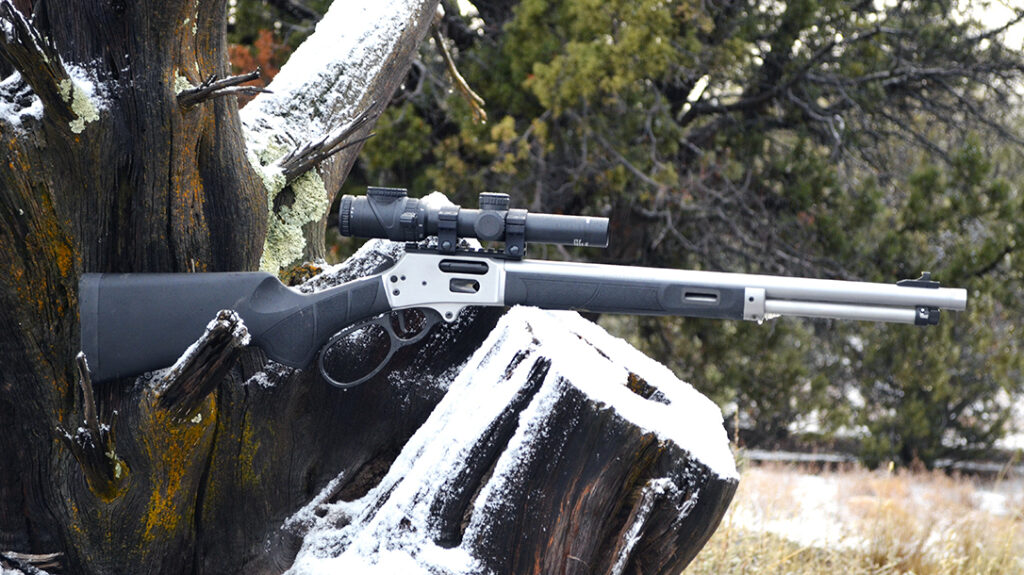
Value-Packed Lever Gun
One of the reasons for the renewed interest in lever guns is because they are just plain fun to shoot, and the 1854 is no different. While at Gunsite there were a number of well-known gun writers who took the time to look at and shoot my T&E gun, and it received high marks from everyone who shot it! S&W set the suggested retail price for the Model 1854 at $1,279. Considering its design, construction and features, I find that a great value for the money! Eventually, S&W will offer the 1854 in .357 Magnum and .45 Colt. There will also be a limited edition of the rifle with a beautiful, blued finish and a stunning walnut stock for $3,499.
For more information on the Model 1854 rifle, visit smith-wesson.com.
Smith & Wesson Model 1854 Specs
| Action | Lever Action |
| Caliber/Capacity | .44 Magnum, 9 + 1 |
| Overall Length | 36. inches |
| Weight | 6.8 Pounds |
| Barrel | 19.25-inch, 410 Stainless-Steel, 1:20” RH Twist, 8-Groove, Muzzle threaded 11/16-24 with Thread Protector Cap |
| Width | 1.6 inches |
| Sights | Rear Sight: XS Sights ghost ring (adjustable), Gold Bead Front Sight, Receiver Mounted Picatinny Rail for Mounting Optics |
| Safety | Cross Bolt Manual Safety |
| Stock | Buttstock-Black Synthetic with Textured Grip Panels with Rubber Recoil Pad, Forend- M-LOK® Synthetic Forend with Textured Grip Panels |
| Receiver | Forged 416 Stainless Steel |
| Lever | Large Loop |
| Magazine Tube | Removable for Fast Unloading |
| Trigger | Flat-Faced Trigger |
| Accessories | Offset Hammer Spur |
| Suggested Retail | $1,279 |



Didn’t find what you were looking for?
Read the full article here

